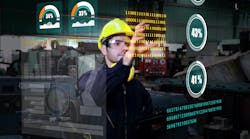Connecting and protecting manufacturing workers in an era of technical skills shortages
The need for connected workers continues to have a fundamental impact on critical challenges for businesses in areas such as workforce skills shortages, operational efficiencies, and worker safety.
Manufacturing companies are facing complex challenges stemming from ongoing technical skills shortages and the onboarding of younger and less experienced staff. Solving these issues could be mission- or even life-critical. Through 2021, manufacturing had the third highest number of non-fatal accidents in the U.S., totaling 334,500, and overall private industry employers reported figures were up 7.5% in 2022, according to the U.S. Bureau of Labor Statistics.
Podcast: How to stop enabling the emergency maintenance culture
Organizations are now opting to use technology to overcome these challenges. This was backed up by a survey Nokia conducted with ABI research last year that revealed many industry sectors were prioritizing workforce operations as the trigger for digital transformation.
Through digital transformation—processes adopted during the Industry 4.0 era—manufacturing companies can lay the foundation to enhance workplace knowledge—and in turn worker safety through widespread connectivity of people, assets and processes. They can use the power of AI and machine learning to analyze huge amounts of operational (OT) data and gain greater awareness of any situation. And they can implement uses cases that allow them to meet their individual goals.
Using technology to connect and protect workers
Training, for example, can be enhanced using augmented, virtual, and mixed reality (AR/VR/XR). New recruits can gain experience of using expensive equipment and working in hazardous situations without any risk. More training can be imparted on-the-job, by providing access to product documentation and videos and allowing workers to instantly connect with offsite experts.
See also: Manufacturing execution systems create quality employees
Knowledge about industrial assets can be further increased by allowing workers to scan machines using their smart devices to access and compare current and historical data. Using devices and smart glasses to overlay VR videos and images on to a machine takes this a step further, guiding workers to areas that need attention. AI capabilities that allow people to converse with machines, using natural language queries, will make tasks more intuitive for less experienced staff.
Traditional mission-critical push-to-talk is enhanced with video and data, allowing teams to gain greater situational awareness. Technologies such as fixed camera positioning can be used to detect people as well as assets, for the monitoring and protection of lone workers. And as automated vehicles and equipment become more prevalent on the factory floor, enhanced tracking and position will be vital to ensure humans can work safely alongside them.
With remote access to environmental and operational data, workers can see round corners and behind doors. Drones can also be deployed to augment their view, removing the need for manual inspections, or used to provide emergency equipment when every second counts.
See also: Protecting OT data under persistent threat from ransomware
Overall, manufacturing companies must evaluate what risks are present in the workplace. As they begin their digital transformation, they will select one or two use cases that solve their initial challenges, but as needs evolve, they will add more. They will also need to carefully choose a technology platform that offers high reliability and is functionally secure so they can manage their digital transformation from the outset.
Building a foundation through private wireless
Robust technology is imperative to keep people and assets connected in an industrial environment such as a factory with a mass of metal structures. Lufthansa Group is one company overcoming the problems of “dead zones” that occur using Wi-Fi or public cellular networks in hangars and workshops.
Primarily driven by the need for remote equipment inspections during the pandemic, a trial proved private 5G wireless was more than up to supporting this mission-critical work and the company is now investigating other ways to apply the technology.
See also: Private 5G networks provide secure foundation for Industry 4.0
By choosing a private 4G or 5G wireless platform that supports Wi-Fi, manufacturers can optimize resources, continuing to use Wi-Fi for IT and other noncritical services. Mission-critical support for real-time tracking and positioning of lone workers, or of robots and people across a factory floor, however, requires real-time data processing. This can only be done by a secure, powerful 4G and 5G private wireless network that incorporates an industrial edge, and as needs grow, through micro edges that allow data to be processed even closer to the source.
With connectivity and secure on-premises data processing enabled, manufacturers can begin connecting workers and machines. When it comes to worker connectivity, smart ruggedized devices that are built to withstand harsh industrial environments or that offer EX-protection in explosive atmospheres are a must.
See also: How one manufacturer made all its digitized data easily searchable. Hint: It was AI
Devices with large screens and buttons and accessories, such as remote speaker microphones and helmets with integrated headsets ensure, workers don’t have to remove PPE to or halt work to communicate with others.
With a robust technology platform in place, manufacturers can select from a rich ecosystem of applications, to protect workers and enhance productivity. By deploying a single platform that incorporates 4G/LTE or 5G private wireless and Wi-Fi connectivity as well as industrial edge data processing and ruggedized devices as a foundation for this digital transformation, they will gain the greatest advantages.
This will allow them to accelerate the introduction of new functionality to address needs faster, and by leveraging synergies across such a platform, they can grow capabilities seamlessly as their needs evolve.




